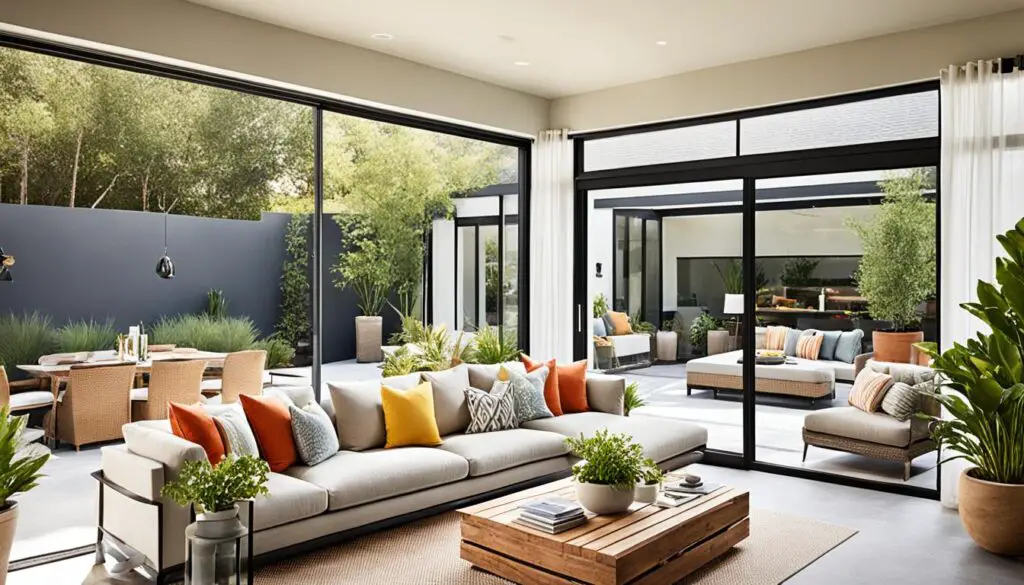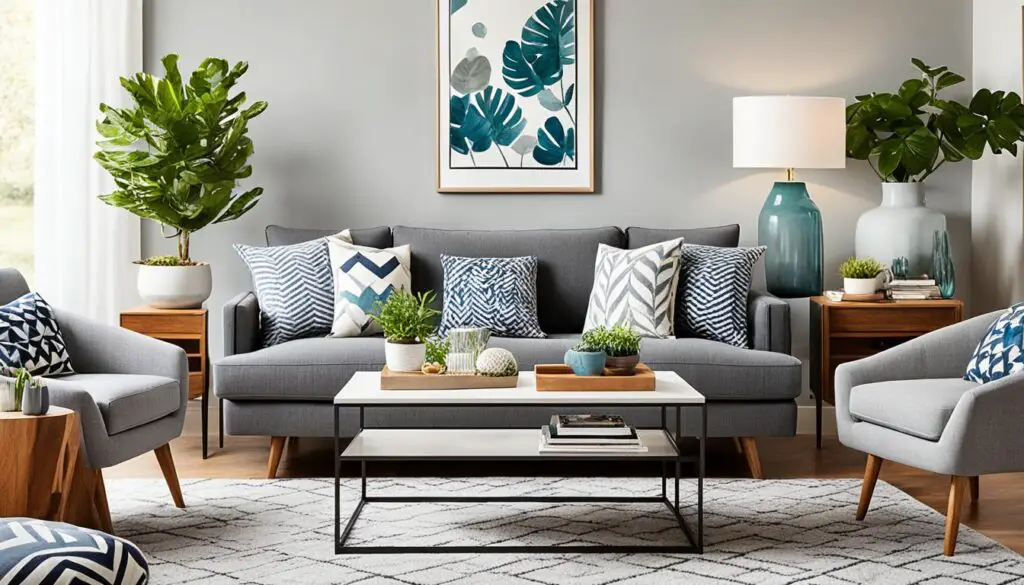Creating a living room and dining room combo needs creativity. It’s about blending style and function. Open concept spaces are trendy, but finding the right mix can be tough. This guide shares 20 ways to make your combo area both useful and stylish.

Consider round dining tables for saving space. Scandinavian light wood tones are also great for small areas. Accent walls, area rugs, or coastal setups near windows can help divide spaces without walls.
Whether you like mid-century modern or eclectic movable tables, there’s an idea for you. The article will help with layout, furniture, and decor to make your combo space inviting.
1. Understanding the Living Room and Dining Room Combo Concept
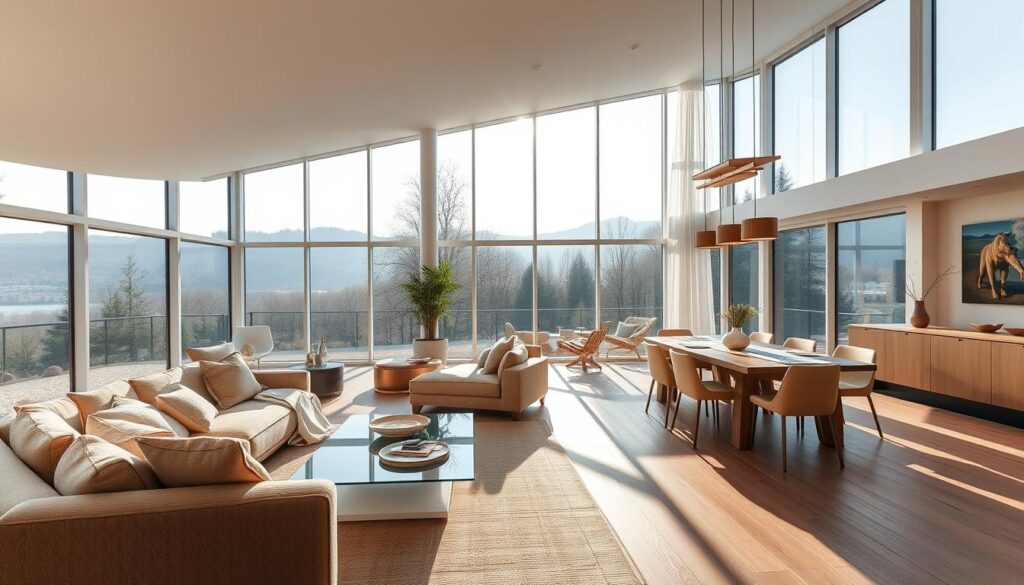
Modern homes often blend spaces to make them more functional and stylish. A living room and dining room combo combines these areas into one open concept living room and dining room. This design removes walls, creating a space that flows well.
What is a Combo Space?
This design merges two areas into one space. Imagine a sofa next to a dining table, connected by a shared rug. Decor like lighting or colors ties the areas together without walls.
Benefits of a Combined Area
- Encourages conversation between social and dining areas
- Maximizes natural light by eliminating barriers
- Offers versatile floor plans for small or large homes
| Layout Ideas | Design Tips |
|---|---|
| L-shaped furniture arrangement | Use same color palette for both zones |
| Central dining table placement | Install pendant lights above eating areas |
| Corner dining setups | Place area rugs to define zones |
Architects like Frank Lloyd Wright started the open concept trend. They focused on harmony between living and dining. Today, this style fits modern life, offering both practicality and style. Whether you’re updating or redecorating, the combo concept balances function and beauty.
2. Choosing the Right Layout for Your Space
Smart layout planning is key to making your combo space work. Whether you want an open flow or clear zones, the right strategy turns tight spaces into functional havens. Start by matching the design to your lifestyle and room size.
Open Floor Plan vs. Defined Spaces
An open layout keeps the room feeling airy, while defined zones add structure. Position the sofa’s back toward the dining area to create separation without walls. Rugs and lighting act as visual guides.
For small living room dining room combo setups, a round table saves space and keeps traffic flowing. Large furniture like sectionals sofas anchor the room while directing pathways.
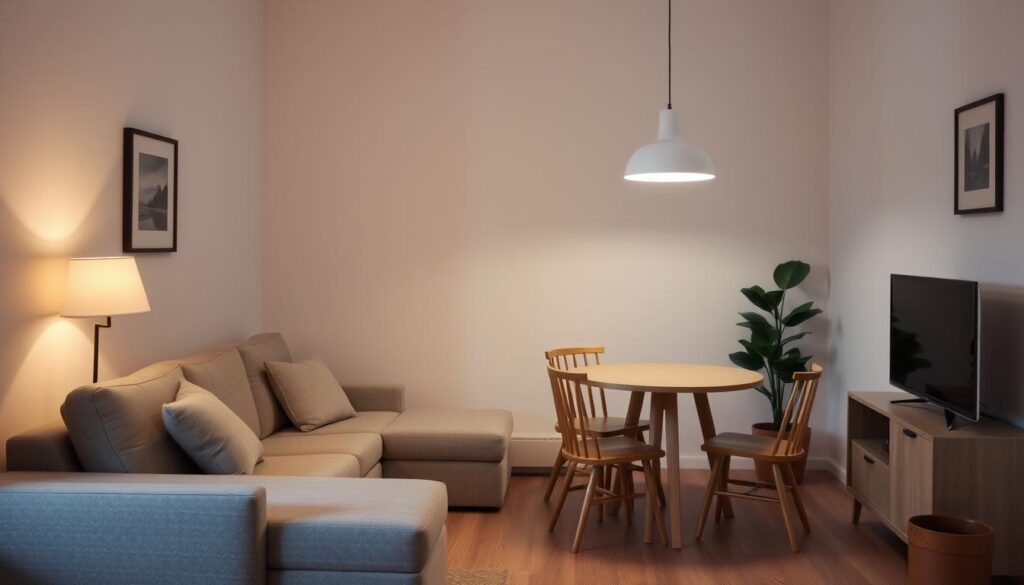
Furniture Arrangement Tips
Face sofas toward focal points like TVs or fireplaces to guide sightlines. Group seating in clusters to avoid a cavernous feel. Pro tips include:
- Leave 36-inch walkways between zones for easy movement.
- Float furniture to create intimate nooks instead of wall-hugging arrangements.
- Match colors or shapes across both areas to maintain cohesion.
- Use floating shelves or tall bookshelves to add storage without taking up floor space.
Lighting layers and strategic rugs finalize the setup. A plush rug under the living area and a flat-weave option for dining creates subtle divisions. Every piece should serve both spaces, from extendable tables to storage ottomans. Proper furniture placement for living room and dining room combo ensures style and function work hand-in-hand.
3. Color Schemes for a Cohesive Look
Choosing the right colors can make a living room and dining room combo look like one space. Start with a neutral base like whites, grays, or warm beiges. This helps create balance. Think about how warm and cool tones affect the room’s mood.
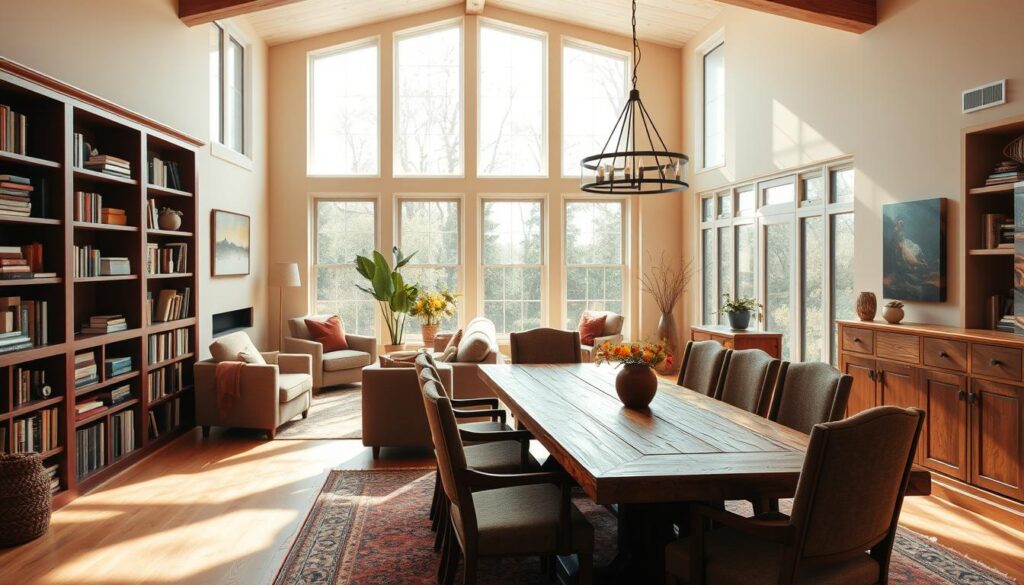
Warm vs. Cool Tones
Warm tones, like Sherwin-Williams Accessible Beige, make living areas cozy. Cool shades, such as soft blues, bring calm to dining zones. Mixing warm wood tones with crisp whites blends function and comfort.
For example, use Sherwin-Williams White Flour on walls and warm wood accents. This anchors the space.
- Warm neutrals (beige, terracotta) suit lounging zones
- Cool tones (blue, gray) work well for formal dining
- Use nature-inspired hues like muted greens for a tranquil feel
Accent Colors to Consider
Accent colors bring the combo space together. Add golden touches to neutral bases or introduce greenery-inspired greens. Follow the 60-30-10 rule: 60% dominant color, 30% secondary, and 10% accent.
For decorating ideas, try these accents:
- Gold accents against black-and-white schemes for modern flair
- Soft coral or fuchsia pops in throw pillows or art
- Coastal blues paired with yellow accents for a beachy vibe
Let trending colors like green or soft blues guide your palette. A muted gold-accented neutral scheme or a coastal blend of blue and white creates cohesive style without overwhelming the space.
4. Selecting Multifunctional Furniture
Maximizing space in a furniture placement for living room and dining room combo requires smart choices. Choose furniture that does more than one thing to reduce clutter. This way, your small living room dining room combo stays both functional and welcoming.

Sofas with Storage
Look for sofas with hidden storage to keep items like blankets and games out of sight. Modular sofas like IKEA’s KIVIK series can be rearranged to fit your needs. MUJI’s designs have under-seat drawers for extra storage. Storage ottomans are great for saving space and adding seating.
Choose pieces in colors like cream or grey to keep your space looking cohesive.
Extendable Dining Tables
- Drop-leaf tables expand with a flip, perfect for sudden gatherings.
- Gate-leg designs add a rustic touch while saving space.
- High-gloss tables in white or black fit well in modern homes.
| Furniture Type | Features | Benefits |
|---|---|---|
| Storage Sofas | Hidden compartments, modular designs | Reduces clutter, adapts to needs |
| Extendable Tables | Expandable leaves, sleek finishes | Flexible seating for any event |
| Wall-Mounted Tables | Pull-down systems, compact storage | Saves space without sacrificing style |
Choose furniture made from sustainable European materials for durability. Mixing finishes like velvet and leather adds interest without making small spaces feel cramped. Spend more on multifunctional items—they’re worth it for long-term benefits.
5. Creating Zones with Rugs
Area rugs are key for living room and dining room combo spaces. They set up natural boundaries without walls. This turns open areas into organized zones. A well-chosen rug can anchor furniture and guide the eye, making each area feel intentional yet connected.

First, look at your room’s layout. For the dining area, pick a round or oval rug that fits under the table. Make sure dining chairs sit on the rug’s edge, leaving 12-18 inches of space to walls. In the living area, a large rectangular rug under seating groups grounds the space. Make sure sofa legs rest on the rug to avoid a floating look.
- Shape Strategy: Round dining rugs frame tables while rectangular living room rugs define seating. Dining rugs should extend past chairs to avoid cluttered edges.
- Color Harmony: Use neutral tones as a base, then layer patterns like geometric or floral designs for visual depth. Match accent colors across zones to maintain cohesion.
- Layering Tips: Place a solid-color rug as a foundation, then add smaller patterned rugs on top. Layered rugs soften floors and add texture without overwhelming the space.
Materials are important too. Choose spill-resistant synthetic rugs in dining zones. Brands like Room & Board or West Elm offer stylish options that last. Mix textures like wool for living areas and jute for dining to balance durability and aesthetics.
Rugs are flexible solutions for decorating ideas for living room and dining room combo. They redefine spaces affordably and can be swapped seasonally to refresh the look. Whether subtle or bold, rugs turn open spaces into functional, inviting zones.
6. Incorporating Lighting Solutions
Lighting can make a living room and dining room combo both functional and stylish. The right lights and natural light can turn open spaces into cozy, inviting areas. These spaces are perfect for any occasion.
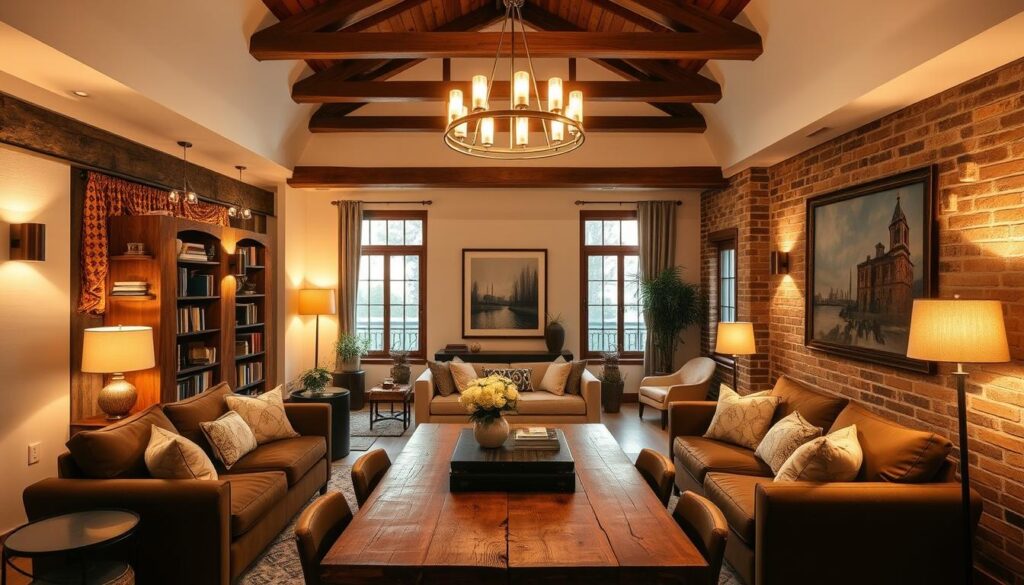
Choosing the Right Fixtures
Make dining areas stand out with bold lights like modern pendants or sleek chandeliers. For the living area, add dimmable floor or table lamps for cozy reading spots. Mix styles, like industrial wireframes or minimalist designs, to fit your decor.
- Hang a pendant light above the dining table to create a focal point.
- Use dimmable lamps in the living area for adjustable lighting.
- Choose wireframe fixtures for a modern industrial vibe.
Natural Light Considerations
Use sheer curtains to let sunlight in while keeping things private. Mirrors opposite windows can make small spaces look bigger. Avoid heavy drapes to keep the space feeling open.
Combining natural light with artificial sources like table lamps and overhead lights is key. This way, you can adjust the lighting for any event, whether it’s dinner or just relaxing.
7. Stylish Divider Options
Creating a visual boundary between your open concept living room and dining room doesn’t need walls. Try these smart divider ideas that blend style with function:
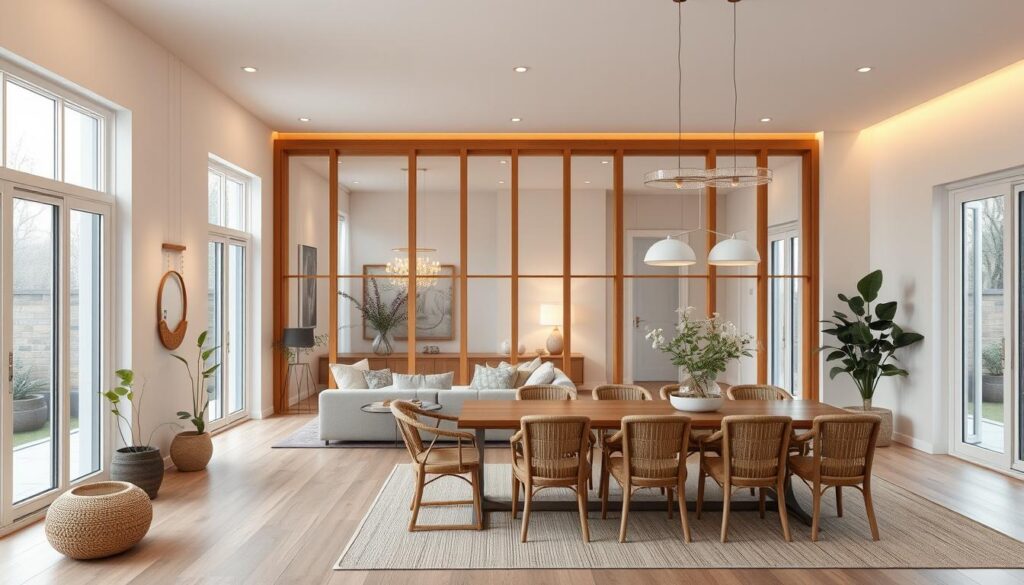
Bookshelf Dividers
Turn storage into art. Full-height bookshelves with open backs let light flow while separating spaces. For smaller rooms, half-height shelves add style without blocking views. Brands like IKEA offer modular units that fit your decor. Decorating ideas for living room and dining room combo include arranging books vertically to highlight artwork or plants on upper shelves.
| Type | Style | Function |
|---|---|---|
| Industrial | Exposed metal frames | Storage + edgy flair |
| Minimalist | Clean lines | Lightweight separation |
| DIY Glass | Transparent panels | Privacy without walls |
Flexible Screens and Greens
Choose moveable solutions like folding screens from HGTV’s collections or tension pole dividers. Add life with pony walls of wood slats or floor-to-ceiling plants. A pony wall with wood slats can frame a dining area while letting light pass through. Even a tall fiddle-leaf fig placed strategically works as a natural divider.
- Screen options: Bamboo weaves, geometric patterns, or mirrored surfaces
- Plant dividers: Group potted palms or use vertical gardens
- DIY hacks: Hang gallery-wrapped canvases on a tension rod
Balance aesthetics and adaptability—mix these ideas to tailor your open concept living room and dining room without sacrificing flow.
8. Artwork and Decor Integration
Starting to mix art into a living and dining combo space involves design tips for living room and dining room combo. These tips help balance both unity and distinction. A gallery wall can turn blank walls into lively highlights.
Try grouping framed art, family photos, or abstract prints in a geometric pattern. This adds interest without making it too crowded.
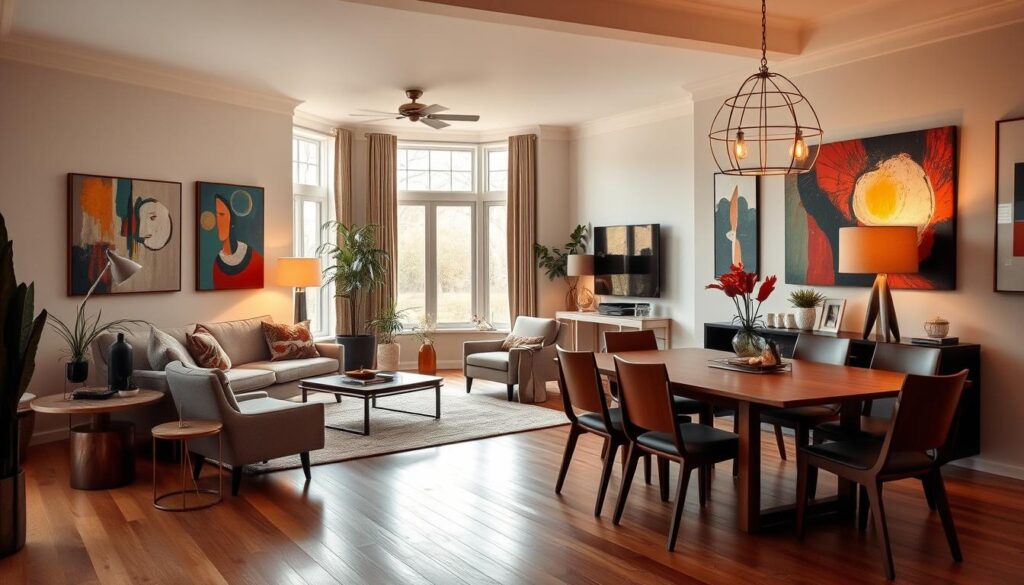
- Gallery Wall Strategy: Mix horizontal and vertical frames in a cohesive color palette. For example, pair coastal landscapes in the living area with abstract pieces in the dining zone using the same blue tones.
- Statement Pieces: Anchor spaces with bold decor like a metallic floor mirror or a sculptural vase. IKEA’s Poäng mirrors or West Elm’s geometric plant stands work well as conversation starters.
Unify the space with repeated motifs—think floral patterns on dining chairs echoed in a living room throw pillow. Use a decorating ideas for living room and dining room combo approach. This means one area’s art style complements the other’s textiles.
A large abstract painting above the dining table can create balance when paired with minimalist living room decor.
Pro tip: Hang art at eye level (58-60 inches from the floor) for optimal viewing. For high ceilings, cluster smaller pieces vertically to draw the eye upward. Let artwork and decor tell your story—whether modern, rustic, or eclectic—while maintaining visual harmony between both zones.
9. Incorporating Plants for Freshness
Plants make a small living room dining room combo lively and healthy. They bring life to open spaces, improve air quality, and add beauty. Pick plants that do well indoors to keep things easy.
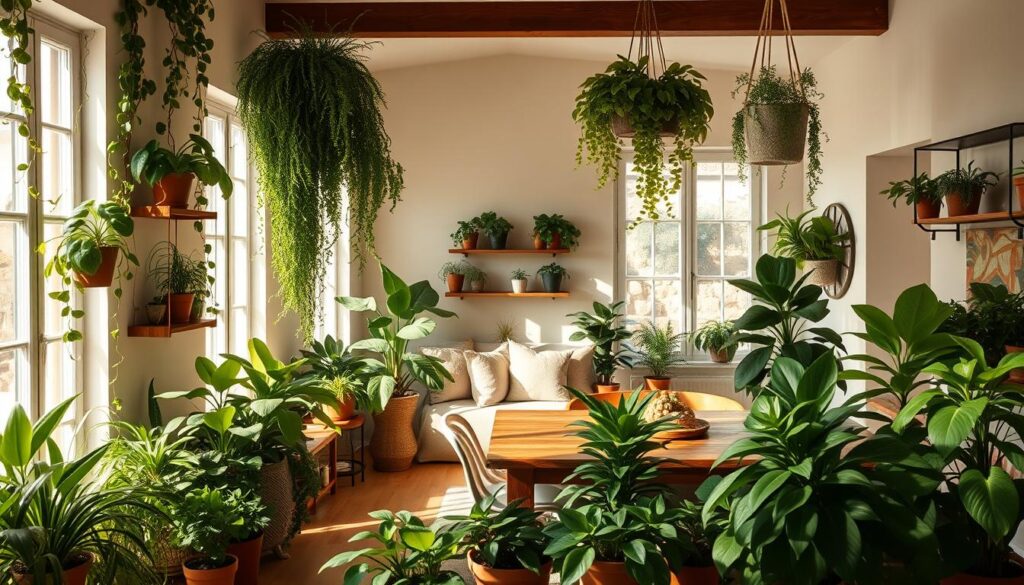
Best Indoor Plants for Small Spaces
Choose plants that fit small spaces and your style. Here are some great options:
- Alocasia: Dramatic foliage for modern setups
- Calathea: Colorful patterns in Boho or Japandi designs
- Dracaena: Tolerant of low light and occasional neglect
- Monstera: Adds tropical flair with large leaves
- Pothos: Trailing vines perfect for shelves or hanging pots
Vertical Gardening Solutions
Use vertical displays to save space. Here are some ideas:
| Option | How It Works | Best For |
|---|---|---|
| Wall-mounted planters | Hang small pots or terrariums | Adding greenery without floor space |
| Plant stands | Raise potted plants to eye level | Creating focal points in open layouts |
| Trellis or moss panels | Attach to walls or use freestanding | Modern or natural-themed combos |
Group plants with similar needs together for easier care. Choose pots that match your small living room dining room combo. For example, use ceramic pots in neutral tones or woven baskets for a bohemian look.
“Plants act as natural dividers, softening the flow between living and dining zones.” – Interior Design Magazine
10. Ideas for Functional Dining Areas
To make the most of a small living room dining room combo, think smart about furniture placement for living room and dining room combo. Decide between cozy nooks or formal tables based on your needs. Here’s how to make a space perfect for meals and gatherings.
Dining Nooks vs. Formal Dining Spaces
A breakfast nook with a bench or banquette is great for saving space and adding warmth. Round tables are perfect for small areas because they let people move easily. If you like to host, formal tables are good, but consider extendable designs like drop-leaf tables to fit more guests. Here are some tips:
- Pair nooks with window seats to double as seating and storage.
- Use pedestal tables for easy access in tight corners.
- Choose chairs with open legs to avoid claustrophobic vibes.
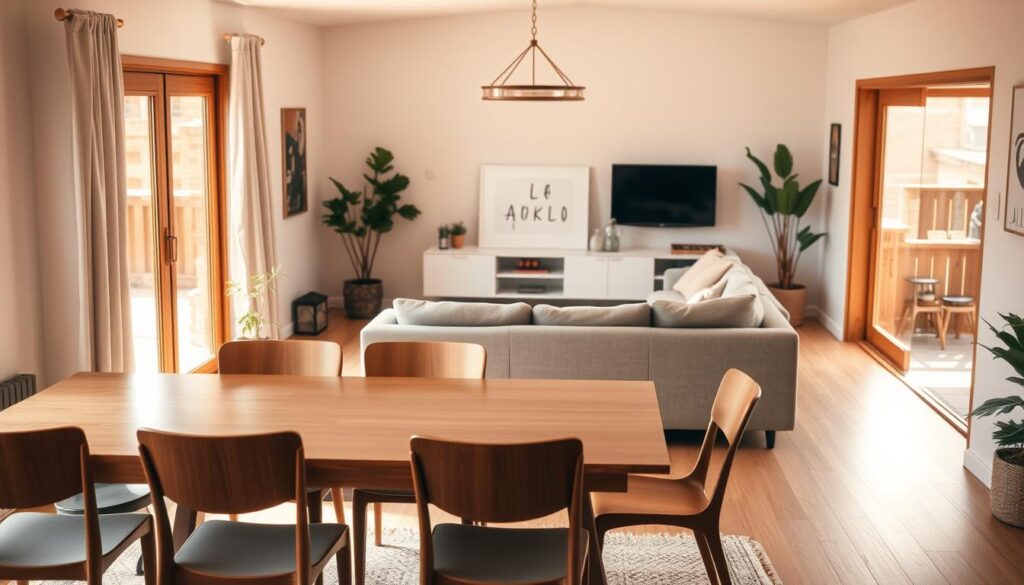
Creative Seating Arrangements
Don’t stick to the “table in the corner” idea. Try these flexible setups:
- Bistro-style: A 2-seat counter-height table near the kitchen feels modern.
- Stackable chairs
- that nest under tables or stack neatly when not in use.
- Bench seating
- along walls or against windows to free up floor space.
Use a bold rug to anchor the dining area without walls. For extra style, add a pendant light above the table for focused lighting and visual separation.
11. Practical Storage Solutions
Maximizing storage in an open concept living room and dining room combo starts with smart design tips. Hidden compartments and vertical solutions keep essentials organized without sacrificing style. Here’s how to balance function and aesthetics in shared spaces.
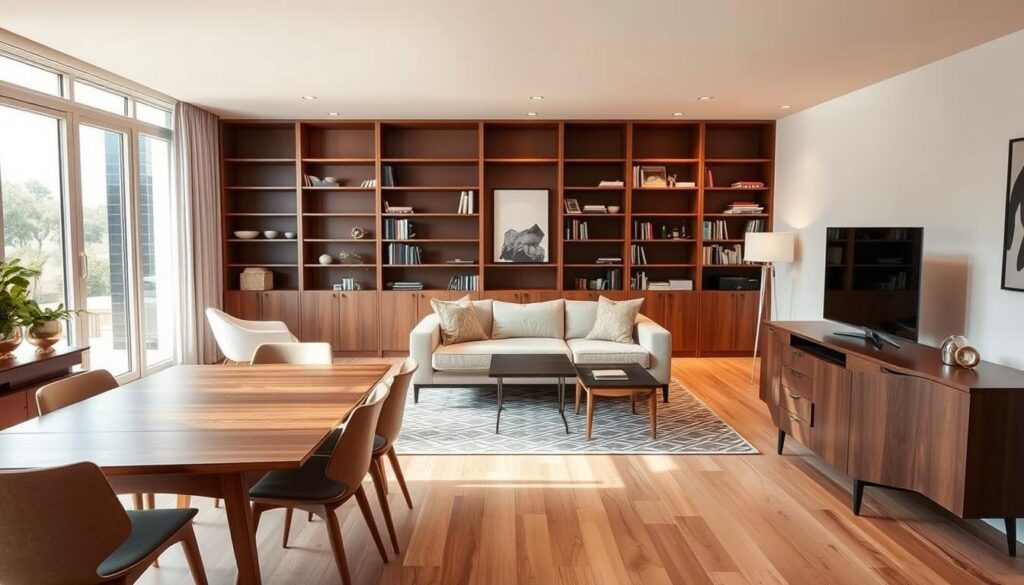
Hidden Storage Made Easy
Turn furniture into storage hubs with these ideas:
- Storage ottomans like the Helene Upholstered Storage Ottoman (Wayfair, $175) hide blankets and games underfoot.
- Under-stairs spaces become custom cabinets with IKEA’s EKET or BROR systems, fitting snugly into tight corners.
- Lift-top dining benches or console tables with drawers store linens or dishes discreetly.
- Console tables like Anthropologie’s Katie Hodges Media Console ($1,198) mix sleek design with hidden compartments for remote controls or decor.
Vertical Space Magic
Raise your game with these upward solutions:
- Float shelves above dining areas to display books or art, freeing floor space.
- Wall-mounted cabinets or floating shelves add storage without overwhelming open layouts.
- Adjustable shelving in neutral tones like IKEA’s IVAR units adapt to your needs while blending into the room.
- Mirrors placed strategically reflect light and make small spaces feel larger, balancing storage with visual flow.
12. Personalizing Your Combo Space
Now that you’ve looked at layouts, colors, and storage, it’s time to make your space your own. A living room and dining room combo shows off your style when you add personal touches.
Highlight Family Stories with Thoughtful Details
Show off your memories with framed photos, travel keepsakes, or family heirlooms. A bold wall hanging or sculptural lamp can be a room anchor. Add warmth with textured throws or ceramic pieces, but don’t overdo it.
Mix Passion and Practicality in Every Corner
Let your hobbies influence the space. Stack your favorite books on a storage ottoman or display art supplies near your dining area. Choose a style that fits your taste, like coastal whites or bohemian layers, but keep colors consistent.
Add functional touches like extendable tables or shelves for souvenirs. Whether you love rustic charm or modern minimalism, your combo should feel like home. Small touches like a handwritten gallery or vintage maps make your space special.

